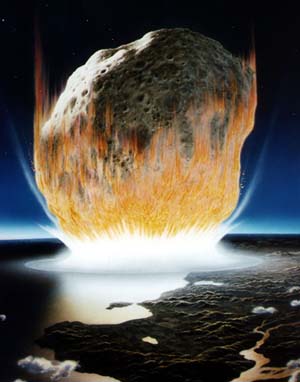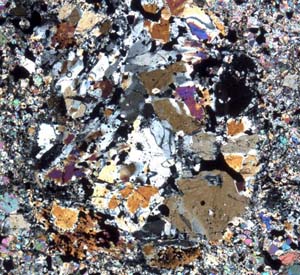|
Fragments of an ancient asteroid have revealed new details about asteroid impacts on Earth.
by Sandrine Ceurstemont and Tobias Selin
 Credit: Don Davis
Credit: Don Davis
What the Morokweng asteroid may have looked like as it hit the Earth 144 million years ago.
|
|
In Morokweng, South Africa, lies a crater larger than the city of London. With a diameter of over 70 km, it is one of the ten largest craters on the planet and was created when a huge asteroid collided with the Earth about 144 million years ago. Usually, asteroids large enough to create craters more than four kilometres wide are vaporised by the high temperatures created when they hit the Earth. But recently, an international group of scientists accidentally discovered a fragment of an asteroid in the Morokweng crater that is believed to be a piece of the destructive, ancient space rock.
Dr Iain McDonald from Cardiff University and Adrian Boyce from Scottish Universities Environmental Research Centre were two of the researchers responsible for the Morokweng discovery published in Nature in May 2006. The scientists were helping a mining company search for copper and nickel in the crater when by chance, one of the boreholes drilling into the crater struck a 25 cm fragment of what appeared to be a meteorite. "The recovery of the meteorite represents a huge stroke of good fortune," says Boyce. "Had the borehole been sited just a metre away, it might have missed the object altogether."
By analysing the minerals and chemicals in the fragment, the scientists were able to confirm that it was indeed part of an asteroid - more specifically an LL chrondite which accounts for 9% of meteorites that strike the Earth and originated from the main asteroid belt between Mars and Jupiter. More searching in the crater also revealed that this wasn't the only fragment that had survived the impact: there were many other pebble-sized pieces lodged inside.
This was a big surprise since it contradicts simulations of the behaviour of large asteroids when they hit the Earth. Models generally assume an initial impact velocity of 20 km/s, and under almost all conditions, this would completely obliterate the meteorite. But McDonald says that the fragments found at Morokweng suggest that the initial velocity with which it hit the Earth was much lower - perhaps in the ballpark of 15 km/s. "The velocity of the asteroid as it impacts the Earth is a key variable," says McDonald. "If you change it, you change what might survive impact and what might not."
 Credit: Dr Iain McDonald
Credit: Dr Iain McDonald
Inside the Morokweng meteorite: these round melt droplets (chrondules) were formed from dust and gas at the start of the Solar System.
|
But the velocity of the asteroid wasn't
the only surprise. Its composition was very different from that
of other asteroid remains found on Earth: it did not contain iron-nickel
metal. This seems to indicate that the fragments are from a different
part of the asteroid than other known meteorites.
Its effect on living species also goes
against what one would expect from an impact of its scale. Large
asteroids typically cause mass extinctions, like the one that hit
Chixculub, Mexico 80 million years ago and is believed to have wiped
out the dinosaurs. "Undoubtedly, life in the immediate vicinity,
hundreds of kilometres from the centre of Morokweng, had a pretty
dreadful time, but there is currently no evidence that the Morokweng
impact created any kind of mass extinction," says McDonald.
No evidence - but patterns of extinction and climate change from the time period when the Morokweng asteroid touched down are pretty hazy. It impacted on Earth right at the boundary of the Jurassic and Cretaceous eras when Africa, South America and Antarctica were still joined together. Extinctions that occurred during this period are not well understood and there is debate as to whether certain extinctions happened at the same time due to a single event, or at different times due to local factors.
Whether or not an asteroid will affect living species has a lot to do with the composition of the ground it crashes into. The Morokweng asteroid impacted into rocks made of granite, amphibolite and banded ironstone which do not release sulphur dioxide and other environmentally-damaging gases. "Unlike the evaporite rocks at the Chixculub crater, these target rocks are pretty benign," says McDonald.
But the speed of the impact could also
have a lot to do with its effect on living things. The research
team hopes that their work at Morokweng will prompt further investigations
into the conditions of the event. "Since numerical simulations are
very complex and involve lots of supercomputer time, simulations
at velocities less than 20 km/s have not been performed, or at least
published," says McDonald. If researchers are able to replicate
the features they observed at the crater, it could give us greater
insight into how this catastrophic event, and other similar ones,
affected our planet.
For more information:
Science Museum - Shock Discovery of Ancient Space Invader
http://www.sciencemuseum.org.uk/antenna/asteroidimpact/
BBC - Relic of Ancient Asteroid Found
http://news.bbc.co.uk/1/hi/sci/tech/4757545.stm
|
